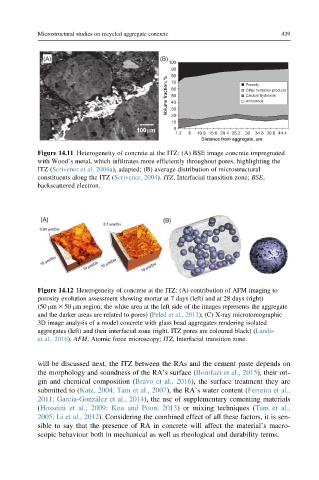Page 489 - New Trends in Eco efficient and Recycled Concrete
P. 489
Microstructural studies on recycled aggregate concrete 439
(A) (B)
100
90
80
Volume fraction, % 70 Porosity
60
Other hydration products
Calcium hydroxide
50
Anhydrous
40
30
20
10
100μm 0
1.2 6 10.8 15.6 20.4 25.2 30 34.8 39.6 44.4
Distance from aggregate, μm
Figure 14.11 Heterogeneity of concrete at the ITZ: (A) BSE image concrete impregnated
with Wood’s metal, which infiltrates more efficiently throughout pores, highlighting the
ITZ (Scrivener et al. 2004a), adapted; (B) average distribution of microstructural
constituents along the ITZ (Scrivener, 2004). ITZ, Interfacial transition zone; BSE,
backscattered electron.
Figure 14.12 Heterogeneity of concrete at the ITZ: (A) contribution of AFM imaging to
porosity evolution assessment showing mortar at 7 days (left) and at 28 days (right)
(50 μm 3 50 μm region; the white area at the left side of the images represents the aggregate
and the darker areas are related to pores) (Peled et al., 2013); (C) X-ray microtomographic
3D image analysis of a model concrete with glass bead aggregates rendering isolated
aggregates (left) and their interfacial zone (right, ITZ pores are coloured black) (Landis
et al., 2016). AFM, Atomic force microscopy; ITZ, Interfacial transition zone.
will be discussed next, the ITZ between the RAs and the cement paste depends on
the morphology and soundness of the RA’s surface (Bonifazi et al., 2015), their ori-
gin and chemical composition (Bravo et al., 2016), the surface treatment they are
submitted to (Katz, 2004; Tam et al., 2007), the RA’s water content (Ferreira et al.,
2011; Garcı ´a-Gonza ´lez et al., 2014), the use of supplementary cementing materials
(Hosseini et al., 2009; Kou and Poon, 2013) or mixing techniques (Tam et al.,
2005; Li et al., 2012). Considering the combined effect of all these factors, it is sen-
sible to say that the presence of RA in concrete will affect the material’s macro-
scopic behaviour both in mechanical as well as rheological and durability terms.

